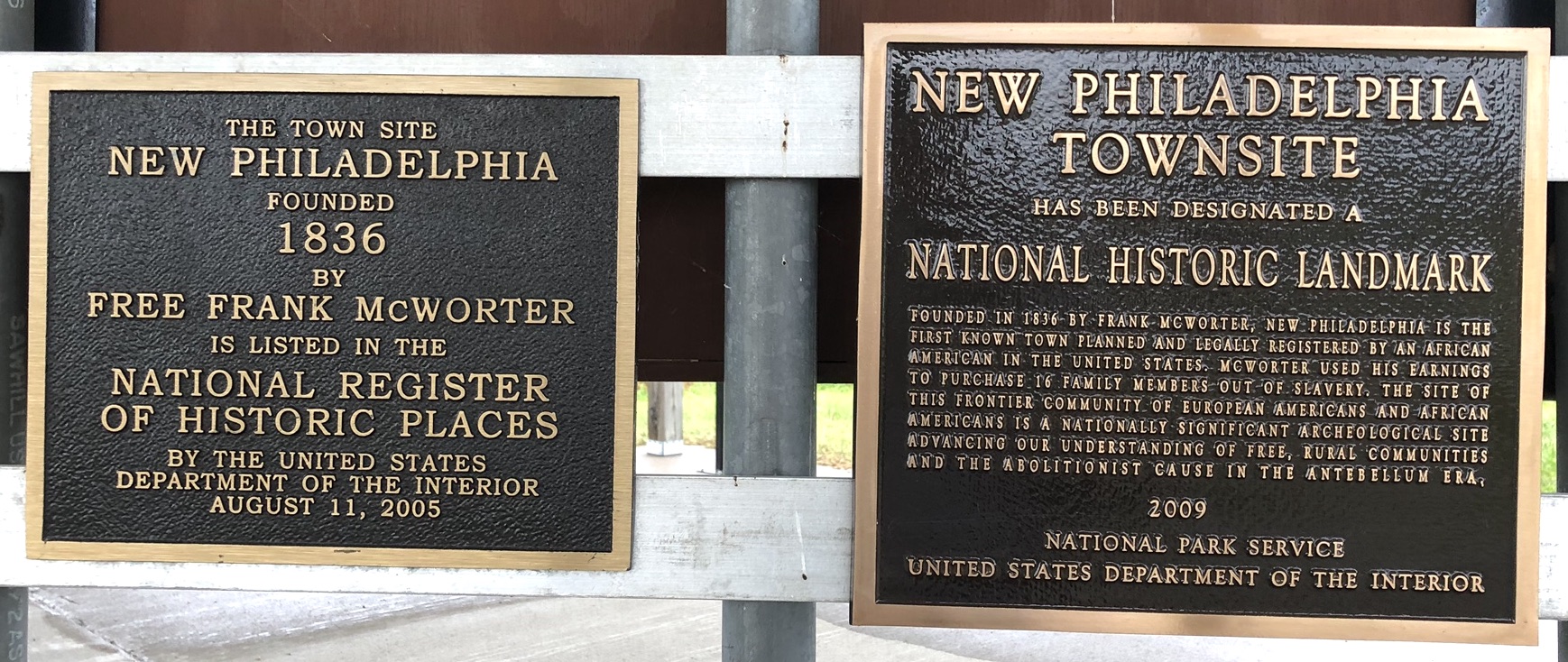UPDATE! New Philadelphia is now a unit of the National Park Service, designated a National Park.

New Philadelphia is the first town in the United States known to have been planned, platted and legally registered by an African American. That African American was Frank McWorter, a former slave who, in 1836, was able to buy a 42-acre piece of land in Pike Country, which he subdivided to form the streets and blocks of the town. He and his wife Lucy had first purchased her freedom in 1817, and Frank’s in 1819 (he came to be called Free Frank McWorter). They later used revenue from the sale of the town lots to purchase freedom for other members of their family.
The town developed as an integrated community, with both African Americans and European Americans moving into New Philadelphia. It was a vibrant, thriving, multi–racial community decades before the Civil War. This was all the more remarkable because of the proximity of New Philadelphia to slave-holding Missouri, only 23 miles away across the Mississippi River to Hannibal.
The town prospered for several decades until the railroad company deliberately bypassed the town in 1869 as it went due west across Illinois. The loop created around, rather than through New Philadelphia, is readily seen on historic maps. This decision brought economic decline for New Philadelphia and by the end of the nineteenth century it was abandoned, to become a ruin by the early 20th century and thence an archaeological site.
In 2002, Dr. Christopher Fennell, a historical archaeologist at the University of Illinois, Dr. Paul Shackel, a historical archaeologist at the University of Maryland and Dr. Terrance Martin, an archaeologist and curator at the Illinois State Museum, organized a multi-institutional team of archaeologists and historians who collaborated with descendant (the large, extended McWorter family remained in Illinois) and local community members to investigate the town site. Years of fieldwork produced a wealth of publications, trained a generation of student archaeologists, and led to several doctoral dissertations.

WATCH this excellent documentary in which Drs. Fennell and Shackel discuss the project (“Prairie Fire: Free Frank and New Philadelphia”, WILL-TV/PBC):
https://www.youtube.com/watch?v=WIin2ATrnDI

WATCH OUR INTERVIEW WITH DR. FENNELL ABOUT THE HISTORY OF FREE FRANK MCWORTER AND LUCY MCWORTER AND THE ACCOMPLISHMENTS OF THE NEW PHILADELPHIA PROJECT: https://mediaspace.illinois.edu/media/t/1_t6e12414 
Among everything important that Dr. Fennell says in the interview (above) is his emphasis on the partnership of Frank and Lucy. Lucy was a co-principal actor at New Philadelphia. In this light, a very interesting project was conducted by seamstress Mary Helen Yokem, a volunteer at the Springfield and Central Illinois African American History Museum. She has reproduced the dress worn by Lucy McWorter in the photo of Lucy in her old age. An excellent video about Lucy and the process of reproducing the dress has been produced.



WATCH this fascinating lecture (June 14, 2022) about New Philadelphia in Frank McWorter’s time, including a discussion of possible engagement with the Mormons of western illinois, presented by Dr. Nancy Davis, Curator Emeritus at the Smithsonian’s National Museum of American History: https://mediaspace.illinois.edu/media/t/1_hr589tg8
ALSO WATCH this talk by Dr. Fennell: https://anthro.illinois.edu/news/2020-02-26/professor-christopher-fennell-new-philadelphia-archaeological-project
An excellent video about New Philadelphia has been produced by “Looking for Lincoln”:
https://www.youtube.com/watch?v=s2tSqo_cETA
An excellent story about New Philadelphia was published in the February 12, 2021 issue of the Chicago Tribune.Through the efforts of the New Philadelphia Archaeological Project and the New Philadelphia Association, New Philadelphia was inscribed on the National Register of Historic Places (2005) and also declared a National Historic Landmark (2009). Note that Dr. Gerald A. McWorter, Professor Emeritus at UIUC, is the great-great-grandson of Frank and Lucy McWorter. He and his wife, Dr. Kate Williams, also at UIUC, are key figures in the New Philadelphia Association and the authors of the important book, shown below.



Why New Philadelphia is a unit of the National Park Service and what it may mean in the future:

Today New Philadelphia can be visited! A large gazebo has excellent interpretive panels explaining the landscape before the viewer.



Posts with QR codes generate AR (augmented reality – see image below) and thus enable the visitor to walk through the site and understand what lies beneath. Visiting New Philadelphia is remarkable experience.

The New Philadelphia Archaeological Project achieved significant public engagement in Pike County where the site is located. Many members of the local society became fascinated by the story of Free Frank McWorter and the town he founded.
Over generations and generations the McWorter family has kept historic records – papers, photos, material objects – about themselves. Through this tangible evidence and oral history they have maintained a close link among themselves and with the past. They have been primary participants in the New Philadelphia Archaeological Project and the New Philadelphia Association. LISTEN to the talk of historian Charlotte Johnson about the descendants of Free Frank McWorter in Illinois: http://newphiladelphiail.org/2020/06/11/charlotte-e-johnson-spoke-on-june-9-2020-recording-here/
KEY REFERENCES
Fennell, Christopher C. Broken Chains and Subverted Plans: Ethnicity, Race and Commodities. (University Press of Florida, 2017)
Fennell, Christopher C., Terrance J. Martin, and Paul A. Shackel (editors), New Philadelphia: Racism, Community, and the Illinois Frontier. IN: Historical Archaeology, Vol. 44, No. 1 (Jan. 2010).
McWorter, Gerald A. and Kate Williams-McWorter. New Philadelphia. (Path Press, 2008)
Shackel, Paul A. New Philadelphia: An Archaeology of Race in the Heartland. (University of California Press, 2010)
Walker, Juliet. Free Frank: A Black Pioneer on the Antebellum Frontier. (University of Kentucky Press, 1983)

